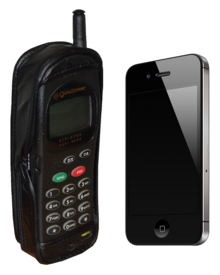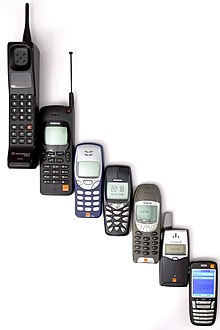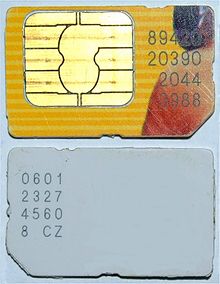Mobile phone
In addition to telephony, modern mobile phones also support a wide variety of other services such as text messaging, MMS, email, Internet access, short-range wireless communications (infrared, Bluetooth), business applications, gaming and photography. Mobile phones that offer these and more general computing capabilities are referred to as smartphones.
The first hand-held mobile phone was demonstrated by John F. Mitchell and Dr Martin Cooper of Motorola in 1973, using a handset weighing around 2.2 pounds (1 kg). In 1983, the DynaTAC 8000x was the first to be commercially available. From 1990 to 2011, worldwide mobile phone subscriptions grew from 12.4 million to over 6 billion, penetrating about 87% of the global population and reaching the bottom of the economic pyramid
History
Main article: History of mobile phones
The first mobile telephone calls were made from cars in 1946. Bell System's Mobile Telephone Service was made on 17 June in St. Louis, Missouri, followed by Illinois Bell Telephone Company's car radiotelephone service in Chicago on October 2. The MTA phones were composed of vacuum tubes and relays, and weighed over 80 pounds (36 kg).
There were initially only 3 channels for all the users in the
metropolitan area, increasing later to 32 channels across 3 bands. This
service continued into the 1980s in large portions of North America. Due
to the small number of radio frequencies available, the service quickly
reached capacity. In 1956 the world’s first partly automatic car phone system, Mobile System A (MTA) was introduced in Sweden.John F. Mitchell, Motorola's chief of portable communication products in 1973, played a key role in advancing the development of handheld mobile telephone equipment. Mitchell successfully pushed Motorola to develop wireless communication products that would be small enough to use anywhere and participated in the design of the cellular phone. Martin Cooper, a Motorola researcher and executive, was the key researcher on Mitchell's team that developed the first hand-held mobile telephone for use on a cellular network Using a somewhat heavy portable handset, Cooper made the first call on a handheld mobile phone on April 3, 1973 to his rival, Dr. Joel S. Engel of Bell Labs.
The new invention sold for $3,995 and weighed two pounds, leading to a nickname "the brick".As I walked down the street while talking on the phone, sophisticated New Yorkers gaped at the sight of someone actually moving around while making a phone call. Remember that in 1973, there weren't cordless telephones or cellular phones. I made numerous calls, including one where I crossed the street while talking to a New York radio reporter - probably one of the more dangerous things I have ever done in my life.
The world's first commercial automated cellular network was launched in Japan by NTT in 1979, initially in the metropolitan area of Tokyo. In 1981, this was followed by the simultaneous launch of the Nordic Mobile Telephone (NMT) system in Denmark, Finland, Norway and Sweden. Several countries then followed in the early-to-mid 1980s including the UK, Mexico and Canada.
On 6 March 1983, the DynaTAc mobile phone launched on the first US 1G network by Ameritech. It cost $100m to develop, and took over a decade to hit the market The phone had a talk time of just half an hour and took ten hours to charge. Consumer demand was strong despite the battery life, weight, and low talk time, and waiting lists were in the thousands.
In 1991, the second generation (2G) cellular technology was launched in Finland by Radiolinja on the GSM standard, which sparked competition in the sector as the new operators challenged the incumbent 1G network operators.
Ten years later, in 2001, the third generation (3G) was launched in Japan by NTT DoCoMo on the WCDMA standard This was followed by 3.5G, 3G+ or turbo 3G enhancements based on the high-speed packet access (HSPA) family, allowing UMTS networks to have higher data transfer speeds and capacity.
By 2009, it had become clear that, at some point, 3G networks would be overwhelmed by the growth of bandwidth-intensive applications like streaming media Consequently, the industry began looking to data-optimized 4th-generation technologies, with the promise of speed improvements up to 10-fold over existing 3G technologies. The first two commercially available technologies billed as 4G were the WiMAX standard (offered in the U.S. by Sprint) and the LTE standard, first offered in Scandinavia by TeliaSonera.
Features
Main article: Mobile phone features
See also: Smartphone
All mobile phones have a number of features in common, but
manufacturers also try to differentiate their own products by
implementing additional functions to make them more attractive to
consumers. This has led to great innovation in mobile phone development
over the past 20 years.The common components found on all phones are:
- A battery, providing the power source for the phone functions.
- An input mechanism to allow the user to interact with the phone. The most common input mechanism is a keypad, but touch screens are also found in some high-end smartphones.
- Basic mobile phone services to allow users to make calls and send text messages.
- All GSM phones use a SIM card to allow an account to be swapped among devices. Some CDMA devices also have a similar card called a R-UIM.
- Individual GSM, WCDMA, iDEN and some satellite phone devices are uniquely identified by an International Mobile Equipment Identity (IMEI) number.
Several phone series have been introduced to address a given market segment, such as the RIM BlackBerry focusing on enterprise/corporate customer email needs; the SonyEricsson Walkman series of musicphones and Cybershot series of cameraphones; the Nokia Nseries of multimedia phones, the Palm Pre the HTC Dream and the Apple iPhone.
Text messaging
Main article: SMS
The most commonly used data application on mobile phones is SMS
text messaging. The first SMS text message was sent from a computer to a
mobile phone in 1992 in the UK, while the first person-to-person SMS
from phone to phone was sent in Finland in 1993.The first mobile news service, delivered via SMS, was launched in Finland in 2000, and subsequently many organizations provided "on-demand" and "instant" news services by SMS.
SIM card
Main articles: Subscriber Identity Module and Removable User Identity Module
GSM feature phones require a small microchip called a Subscriber Identity Module or SIM Card,
to function. The SIM card is approximately the size of a small postage
stamp and is usually placed underneath the battery in the rear of the
unit. The SIM securely stores the service-subscriber key (IMSI) and the Ki
used to identify and authenticate the user of the mobile phone. The SIM
card allows users to change phones by simply removing the SIM card from
one mobile phone and inserting it into another mobile phone or
broadband telephony device.The first SIM card was made in 1991 by Munich smart card maker Giesecke & Devrient for the Finnish wireless network operator Radiolinja.
Multi-card hybrid phones
A hybrid mobile phone can hold up to four SIM cards. SIM and RUIM cards may be mixed together to allow both GSM and CDMA networks to be accessed.From 2010 onwards they became popular in India and Indonesia and other emerging markets, attributed to the desire to obtain the lowest on-net calling rate. In Q3 2011, Nokia shipped 18 million of its low cost dual SIM phone range in an attempt to make up lost ground in the higher end smartphone market
Kosher phones
There are Jewish orthodox religious restrictions which standard mobile telephones do not meet. To fulfill this demand, phones without Internet access, text messaging or cameras are required These restricted phones are known as kosher phones and have rabbinical approval for use in Israel and elsewhere by observant Orthodox Jews. Some are even approved for use by essential workers (such as health, security and public services) on the sabbath, even though use of any electrical device is restrictedAlthough these phones are intended to prevent immodesty, some vendors report good sales to adults who prefer the simplicity of the devices.








0 comments:
Post a Comment